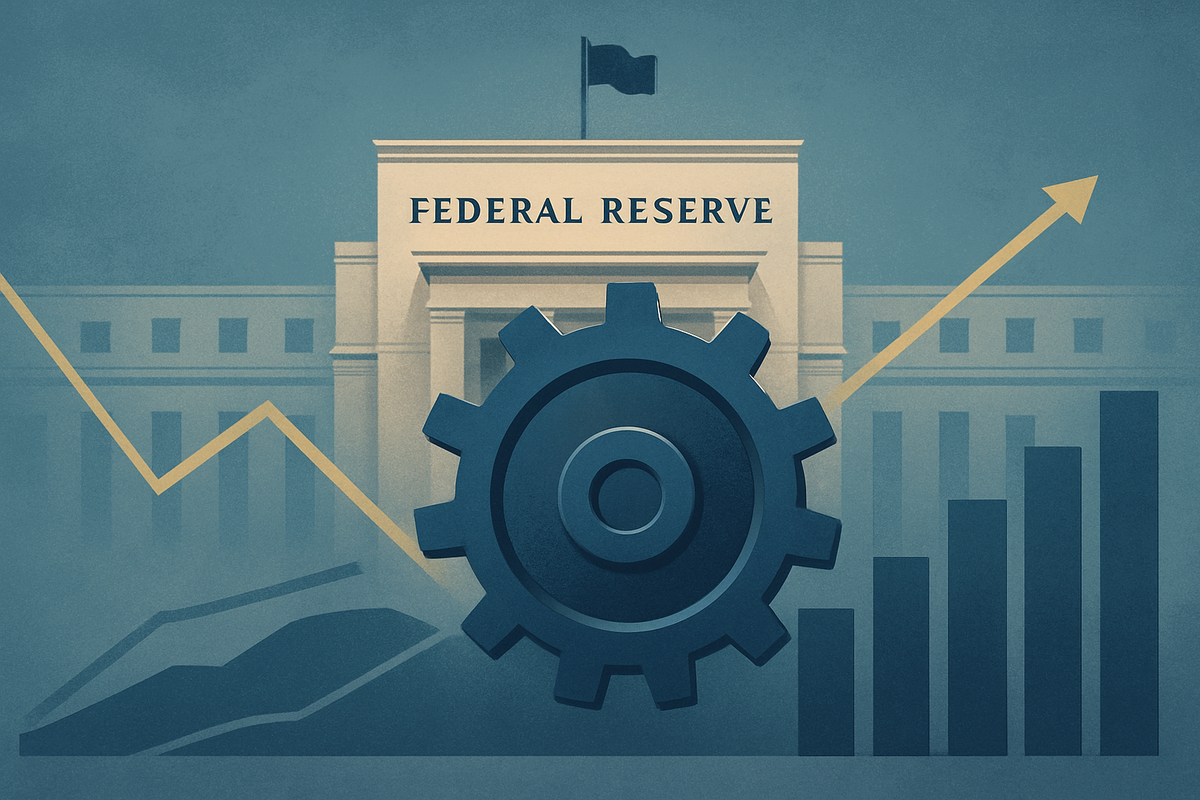Federal Reserve Hits the Brakes on Quantitative Tightening: A Pivotal Shift in Monetary Policy

The Federal Reserve has announced a significant shift in its monetary policy, signaling an end to its aggressive balance sheet reduction, commonly known as Quantitative Tightening (QT). In a pivotal decision made in October 2025, the Federal Open Market Committee (FOMC) declared its intention to conclude the reduction of its aggregate securities holdings on December 1, 2025. This move marks a critical juncture in the Fed's post-pandemic strategy, indicating that policymakers believe bank reserves are approaching an "ample" level, thereby easing concerns about money market liquidity and potentially ushering in a new phase of monetary accommodation.
This strategic pivot has immediate implications for financial markets, suggesting a less restrictive financial environment than previously anticipated. While the Fed's primary focus remains on combating inflation, the decision to halt QT reflects a careful balancing act, acknowledging the potential for undue stress on the banking system and broader economy. The debate surrounding the optimal size and composition of the Fed's balance sheet, and its role in influencing economic conditions, is now set to intensify as markets digest this crucial policy shift.
The Fed's Retreat from Balance Sheet Reduction: Details and Drivers
The FOMC's decision in October 2025 to cease its balance sheet runoff on December 1, 2025, is a direct response to evolving conditions in money markets. Since June 2022, the Fed had been steadily shrinking its balance sheet from a peak of nearly $9 trillion, accumulated during the COVID-19 pandemic's Quantitative Easing (QE) programs. By October 2025, the balance sheet had been reduced by over $2 trillion, settling in the range of $6.25 trillion to $6.5 trillion. This aggressive reduction was a key component of the Fed's efforts to withdraw liquidity and combat soaring inflation.
The rationale behind the abrupt halt stems from clear market-based indicators suggesting that bank reserves, a crucial component of the Fed's liabilities, were transitioning from "abundant" to "somewhat above ample." These warning signs included increased volatility in repurchase agreement (repo) rates, particularly around tax payment deadlines and Treasury issuance dates, and a more frequent reliance on the Fed's standing repo facility by banks. Fed Governor Christopher Waller has estimated the minimum "ample" level of reserves to be around $2.7 trillion, and with bank reserves dipping below $3 trillion by October 2025, the central bank opted for caution. Fed Chair Jerome Powell, while still characterizing reserves as "abundant," acknowledged their proximity to the "ample" threshold, underscoring the committee's preemptive action.
Key players in this ongoing debate include not only the current FOMC members but also external voices. Kansas City Fed President Jeffrey Schmid has been a vocal advocate for operating with the "smallest and least distortive balance sheet" possible, arguing that a large balance sheet blurs the lines between monetary and fiscal policy. Similarly, Fed Vice Chair Bowman supports a smaller balance sheet. Conversely, external critics like former Fed Governor Kevin Warsh and Treasury Secretary Scott Bessent have intensified calls for an even more aggressive reduction, criticizing past QE for fostering a "wealth effect" and acting as a "de facto backstop for asset owners." The decision to halt QT, therefore, reflects a nuanced internal consensus prioritizing financial stability over a continued, potentially disruptive, reduction in liquidity.
Market Implications: Winners, Losers, and Economic Shifts
The Federal Reserve's decision to halt Quantitative Tightening on December 1, 2025, is poised to create distinct winners and losers across various sectors of the economy, primarily by influencing interest rates and overall financial conditions. The immediate implication is a less restrictive monetary environment than if QT had continued, potentially leading to lower long-term interest rates than otherwise expected.
Potential Winners: Companies sensitive to interest rates are likely to benefit. The housing sector, including homebuilders like D.R. Horton (NYSE: DHI) and Lennar (NYSE: LEN), and mortgage lenders, could see a boost as borrowing costs stabilize or even decline from their peaks. The automotive industry, with major players such as General Motors (NYSE: GM) and Ford (NYSE: F), which relies heavily on consumer financing, could also experience increased demand. High-growth technology companies that often depend on access to cheaper capital for expansion and innovation, such as Amazon (NASDAQ: AMZN) or Microsoft (NASDAQ: MSFT), might find a more favorable funding environment. Furthermore, banks like JPMorgan Chase (NYSE: JPM) and Bank of America (NYSE: BAC) could benefit from reduced money market stress and greater stability in their reserve levels, although their net interest margins might face some pressure if rates decline. Companies with significant debt loads could also see their refinancing costs ease.
Potential Losers: While the overall impact tends to be more broadly positive for the economy, some entities might find themselves in a less advantageous position. Companies that thrived in a higher interest rate environment or those whose business models are predicated on tighter financial conditions might see some headwinds. For instance, certain segments of the financial industry that benefit from wider interest rate differentials might see some compression. Additionally, any entities that had been positioning for a continued, aggressive tightening cycle might need to re-evaluate their strategies. However, the more significant impact is likely to be a shift in the broader economic narrative rather than direct negative consequences for specific companies, as the Fed's action is generally seen as supportive of economic stability.
Wider Significance: A New Normal for the Fed's Balance Sheet?
The Federal Reserve's decision to halt Quantitative Tightening represents a significant inflection point, fitting into broader industry trends that question the optimal size and role of central bank balance sheets in modern economies. This move suggests a potential shift towards a "new normal" where the Fed's balance sheet might settle at a considerably larger size than pre-2008 levels, even during periods of economic stability. This challenges the long-held aspiration among some policymakers for a return to a minimal balance sheet, primarily composed of Treasury securities. The debate now intensifies over whether the Fed can effectively conduct monetary policy with a perpetually large balance sheet, relying primarily on interest on reserves and standing facilities.
The ripple effects of this decision could be substantial. By signaling a more accommodative stance on liquidity, the Fed might alleviate some of the upward pressure on long-term interest rates, potentially providing a tailwind for investment and consumption. This could also indirectly influence global financial conditions, as the U.S. dollar's strength might be tempered if the perception of aggressive tightening fades. Furthermore, it could shift some of the burden of economic management back towards fiscal policy, as the monetary spigot, while not fully open, is no longer actively tightening. This could lead to renewed calls for fiscal measures to address economic challenges, potentially blurring the lines between monetary and fiscal responsibilities, a concern raised by critics like Kansas City Fed President Jeffrey Schmid.
From a regulatory and policy perspective, the decision reignites discussions about the composition of the Fed's assets. The Fed has indicated its intention to continue allowing agency securities, such as mortgage-backed securities (MBS), to run off its balance sheet, reinvesting the proceeds into Treasury bills. This strategy aims to gradually shift the portfolio primarily towards Treasury securities, a composition many policymakers prefer to avoid influencing credit allocation in specific sectors. Historically, the expansion of the Fed's balance sheet during crises, particularly with large MBS holdings, has drawn criticism for potentially distorting housing markets. This gradual rebalancing is an attempt to address those concerns. The current scenario also bears some resemblance to previous periods where the Fed adjusted its balance sheet post-crisis, though the scale and the unique post-pandemic inflationary environment make this a distinct historical moment.
What Comes Next: Navigating the Post-QT Landscape
The Federal Reserve's decision to conclude Quantitative Tightening on December 1, 2025, sets the stage for a dynamic period in financial markets and economic policy. In the short term, markets will be keenly focused on digesting the implications of this policy shift. Investors will be looking for further clarity from Fed officials regarding their long-term vision for the balance sheet's size and composition. The immediate aftermath could see a stabilization or even a slight dip in long-term bond yields, as the supply of bonds from the Fed's runoff diminishes, potentially easing financial conditions. Companies and consumers might experience slightly lower borrowing costs, which could provide a modest boost to economic activity heading into 2026.
In the long term, the cessation of QT raises fundamental questions about the future of monetary policy. One significant possibility is that the Fed's balance sheet will settle at a permanently larger size than historical norms, effectively establishing a "new normal." This would imply that future monetary policy interventions, particularly during economic downturns, might involve even larger-scale asset purchases (QE) if the baseline balance sheet is already substantial. This could lead to a reliance on interest on reserves and standing liquidity facilities as the primary tools for managing short-term interest rates, even with a large balance sheet. Strategic pivots might be required for financial institutions and investors to adapt to an environment where the Fed is no longer actively withdrawing liquidity, potentially leading to a re-evaluation of asset allocation strategies.
Market opportunities could emerge in sectors that are highly sensitive to interest rates and liquidity, such as real estate, utilities, and growth-oriented technology stocks, if the less restrictive financial conditions translate into lower capital costs and improved investor sentiment. However, challenges remain, particularly concerning inflation. While the Fed has paused QT, it has not abandoned its fight against inflation. If inflationary pressures persist or re-emerge, the Fed might need to consider other tightening measures, such as raising the federal funds rate further, or potentially even restarting QT in the future, creating a complex and uncertain outlook. Potential scenarios range from a "soft landing" facilitated by ample liquidity to a renewed inflationary surge that forces the Fed back into a tightening stance.
A Comprehensive Wrap-Up: The Fed's Evolving Stance
The Federal Reserve's decision in October 2025 to halt its Quantitative Tightening program on December 1, 2025, marks a pivotal moment in its post-pandemic monetary policy. The key takeaway is the Fed's proactive response to signs of tightening liquidity in money markets, signaling a prioritization of financial stability as bank reserves approach "ample" levels. This move effectively concludes an aggressive period of balance sheet reduction, initiated in June 2022, which saw over $2 trillion withdrawn from the financial system.
Moving forward, the market will assess this development through the lens of a potentially less restrictive financial environment. While the immediate impact might be a stabilization or even a slight easing of long-term interest rates, the overarching goal of combating inflation remains paramount. The debate surrounding the optimal size and composition of the Fed's balance sheet will continue, with ongoing discussions about the balance between supporting economic activity and avoiding market distortions. This decision underscores the Fed's evolving understanding of its balance sheet as a dynamic tool, rather than merely a residual effect of crisis intervention.
The lasting impact of this decision could be the establishment of a "new normal" for the Fed's balance sheet, settling at a significantly larger size than pre-2008 levels. This implies that future monetary policy operations, including potential future rounds of quantitative easing, would operate from a higher baseline. Investors should closely watch for further communications from the Federal Reserve regarding its long-term balance sheet strategy, as well as incoming inflation data and money market indicators. The interplay between interest rate policy and balance sheet management will define the financial landscape in the coming months and years.
This content is intended for informational purposes only and is not financial advice



